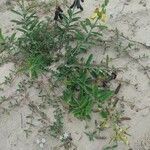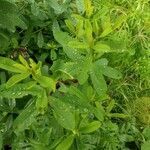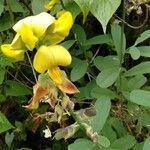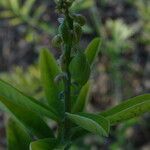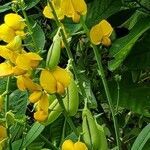Herb, usually less than 1 m tall, stem striate, strigulose. Leaves unifoliolate, oblanceolate, the apex rounded or mucronulate, the base cuneate, 3.5-9.7 cm long, 1.4-3.6 cm broad, the margins entire, above glabrous, beneath puberulent with loosely appressed trichomes, the veins 7-12 on each side of the midvein; petiole 2-3.5 mm long; stipules frequently absent at flowering time, when present narrowly angular ovate and less than 2.5 mm long. Inflorescenses terminal ra-cemes, bearing 14-20 flowers, bracts narrowly triangular, to 2.5 mm long; per-sistent, pedicels 5-9 mm long; bracteoles narrowly triangular, 0.5-1.0 mm long, puberulent, located at mid-pedicel. Flowers yellow, 17-24 mm long, the calyx 12-14 mm long, the tube truncate, the lobes 1.2-1.8 times as long as the tube, strigulose; corolla yellow, occasionally with purple veins, 17-24 mm long, the standard 14-18 mm long, 17-25 mm broad, retuse, the wings 13-15 mm long, the claws 3-4 mm long, oblong lanceolate, oblique, the keel 16-18 mm long, the twisted beak not prolonged; stamens dimorphic, the long anthers 2.8-3.1 mm long, the short anthers 0.8-1.0 mm long; style with a pubescent stigma, genicu-late, 11-12 mm long. Legume inflated, 3.0-3.8 cm long, glabrous, dark brown to black; seeds ca. 23, tan to brown, oblique cordiform, to 4.5 mm long.
Herbs, erect, 60-120 cm tall. Branches terete, pubescent. Stipules subulate, ca. 1 mm. Leaves simple; petiole 2-4 mm; leaf blade oblong to oblanceolate, 3-8 × 1-3.5 cm, abaxially slightly pubescent, adaxially glabrous, veins distinct on both surfaces, base cuneate, apex retuse. Racemes terminal, 10-20-flowered; bracts lanceolate, 2-3 mm. Pedicel 3-5 mm; bracteoles inserted on apical part of pedicel, filiform, very minute. Calyx 2-lipped, 1-1.2 cm, sparsely pubescent; lobes broadly lanceolate. Corolla yellow; standard suborbicular to elliptic, 1-1.5 cm, base with 2 appendages; wings oblong, 1-1.5 cm; keel ± as long as wings, narrowed apically from middle and extended into a long twisted beak exserted beyond calyx. Legume oblong, 3-4 × 1-1.8 cm, 10-20-seeded, glabrous; stipe ca. 2 mm. Fl. Oct-Dec, fr. Jan-Apr.
An annual plant. It grows to 1-1.5 m high and spreads to 1 m across. The stems are erect and slender. The branches are stiff, and shortly hairy. The leaves are oblong to sword shaped, with a blunt end. They are 3-8 cm long by 1-2.5 cm wide. The leaves are green above and pale underneath. They have a short leaf stalk. The flowers occur in clusters 15-30 cm long. These are at the ends of branches. The flowers are yellow and pea shaped. They are 1.5-2 cm long. The fruit are pods 2-5 cm long which are black when ripe. The pods are spreading at right angles. The seeds are golden brown and about 4 mm long.
Standard obovate-circular, pale yellow, veined and outside often suffused reddish-purple, usually puberulous along the midvein outside; wings oblong-obovate, longer than the keel, bright yellow; keel 1.3–1.5 cm long, rounded, with a fairly short slightly incurved twisted beak.
Leaves simple; blade 3.5–11 × 1.5–4 cm, oblanceolate to oblong-obovate, finely appressed pubescent beneath; petiole c. 2–4 mm long; stipules 1–5 mm long, linear or subulate.
Racemes 10–30 cm long, many-flowered; bracts c. 2–6 mm long, subulate-caudate to lanceolate-caudate; bracteoles on the pedicel, 1–2 mm long, filiform.
Erect annual or short-lived perennial, 0.5–1.5 m tall, usually well branched; branches slightly ribbed, subdensely covered with short hairs.
Calyx 1.1–1.4 cm long, glabrous to appressed puberulous; upper lobes broadly lanceolate-triangular, longer than the tube.
Seeds c. 5–5.5 mm long, oblique-cordiform, with the narrow end strongly incurved, finely papillose, yellowish or brown.
Flowers conspicuous, 3/4–1 in. long, in long loose racemes, yellow with purple veining.
Pod shortly stipitate, (3)4–5 × 1–1.8 cm, oblong-clavate, glabrous, c. 12–20-seeded.
A hall-shrubby herb, 2–4 ft. high
